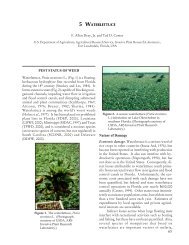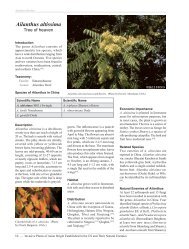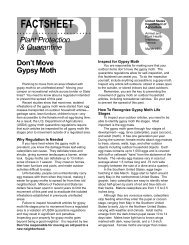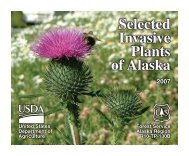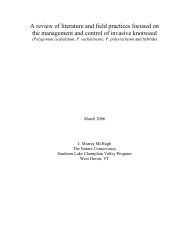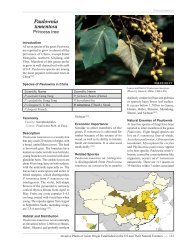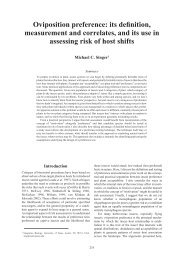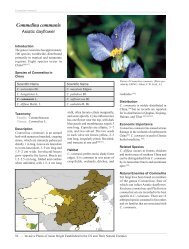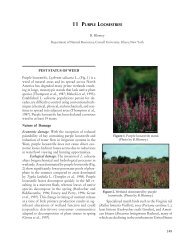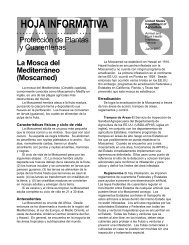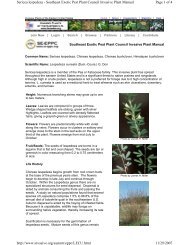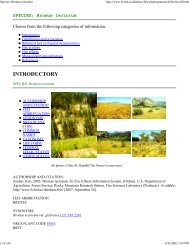A Guide to the Control and Management of Invasive Phragmites [PDF]
A Guide to the Control and Management of Invasive Phragmites [PDF]
A Guide to the Control and Management of Invasive Phragmites [PDF]
You also want an ePaper? Increase the reach of your titles
YUMPU automatically turns print PDFs into web optimized ePapers that Google loves.
underst<strong>and</strong>ing phragmites<br />
control methods<br />
recommended management strategies<br />
fur<strong>the</strong>r information<br />
part 1<br />
part 2<br />
part 3<br />
part 4<br />
15<br />
Because phragmites st<strong>and</strong>s burn hot<br />
<strong>and</strong> fast, safety is paramount when<br />
using prescribed fire <strong>and</strong> a burn plan<br />
should be prepared prior <strong>to</strong> initiating<br />
any work. Preparation <strong>of</strong> a burn plan<br />
will help prevent unintended spot-fires<br />
<strong>and</strong> minimize adverse impacts <strong>to</strong><br />
wildlife, sensitive plant species <strong>and</strong><br />
adjacent property owners. Prescribed<br />
fire must be h<strong>and</strong>led carefully <strong>and</strong><br />
should be conducted only by properly<br />
trained individuals. More information<br />
can be found on <strong>the</strong> Michigan<br />
Prescribed Fire Council website at<br />
http://www.firecouncil.org.<br />
Approval from <strong>the</strong> local municipality<br />
<strong>and</strong> fire department will likely be<br />
required prior <strong>to</strong> <strong>the</strong> prescribed fire.<br />
left: Using prescribed fire after an<br />
initial herbicide treatment,<br />
Erie Marsh Preserve, MI. H. Braun<br />
Prescribed Fire<br />
Prescribed fire is a <strong>to</strong>ol that can be used after an herbicide treatment<br />
<strong>to</strong> remove excess biomass, potentially kill any living rhizomes<br />
<strong>and</strong> promote native plant growth.<br />
In situations where prescribed fire can be<br />
implemented it is easier <strong>to</strong> locate phragmites<br />
regrowth <strong>and</strong> spot-treat those plants<br />
with herbicides once a site has been cleared<br />
<strong>of</strong> <strong>the</strong> thick, dead stems. In situations where<br />
it can be implemented safely <strong>and</strong> effectively,<br />
prescribed fire is a cost-effective <strong>and</strong> ecologically<br />
sound <strong>to</strong>ol <strong>to</strong> help control phragmites.<br />
Prescribed fire is recommended<br />
where phragmites exists in large dense<br />
st<strong>and</strong>s. Use <strong>of</strong> prescribed fire without first<br />
treating with herbicides does not control<br />
phragmites, <strong>and</strong> instead may encourage<br />
rhizome growth <strong>and</strong> cause phragmites populations<br />
<strong>to</strong> become more vigorous.<br />
Prescribed fire should be conducted <strong>the</strong><br />
year following herbicide treatment, ei<strong>the</strong>r<br />
in late summer (mid-July through<br />
August) or winter (January until prior <strong>to</strong><br />
spring green-up). Both options are very<br />
effective in controlling phragmites <strong>and</strong><br />
encouraging native plant growth.<br />
Prescribed fire conducted in late summer<br />
as a second-year treatment following an<br />
herbicide treatment is preferred. A prescribed<br />
fire in late summer destroys seed<br />
heads, removes dead stems, <strong>and</strong> helps kill<br />
any phragmites plants that survived <strong>the</strong><br />
initial herbicide treatment. Burning during<br />
this time frame also will provide for<br />
green-up <strong>of</strong> native plants before first<br />
frost. Late summer prescribed fires<br />
should be conducted when conditions are<br />
as dry as possible <strong>to</strong> achieve a complete<br />
burn <strong>of</strong> plants.<br />
If it is anticipated that a prescribed fire<br />
cannot be accomplished during <strong>the</strong> summer<br />
period, <strong>the</strong>n an earlier burn in <strong>the</strong><br />
winter (January until prior <strong>to</strong> spring<br />
green-up) following an herbicide treatment<br />
is recommended. A winter burn<br />
can prepare <strong>the</strong> site for subsequent herbicide<br />
treatments <strong>and</strong> removes dead<br />
stems, allowing sunlight <strong>to</strong> stimulate new<br />
growth <strong>of</strong> many plant species. Once a site<br />
has been cleared <strong>of</strong> <strong>the</strong> thick, dead stems,<br />
it will be easier <strong>to</strong> locate phragmites<br />
regrowth <strong>and</strong> spot-treat those plants with<br />
herbicides. Be aware, however, that burning<br />
during this time frame can also stimulate<br />
growth <strong>of</strong> phragmites plants that<br />
survived <strong>the</strong> initial herbicide treatment<br />
(Getsinger et al., 2007).


![A Guide to the Control and Management of Invasive Phragmites [PDF]](https://img.yumpu.com/27321025/20/500x640/a-guide-to-the-control-and-management-of-invasive-phragmites-pdf.jpg)

